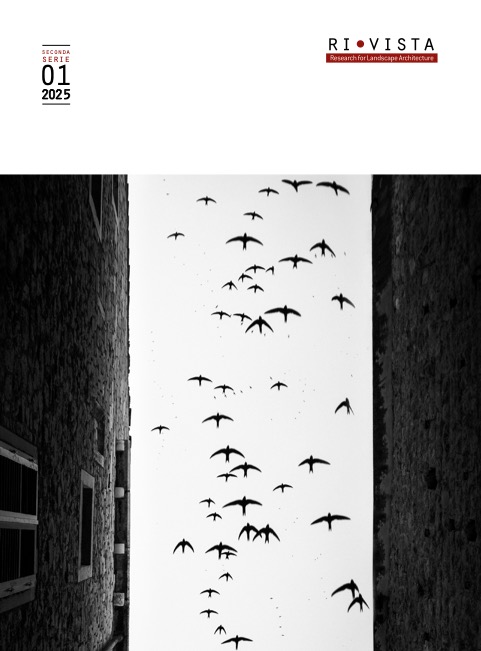Published 2025-10-28
Keywords
- Open space,
- Sky,
- Earth,
- Sea,
- Segmentation
- Continuity/discontinuity,
- Relationships,
- Pervasiveness ...More
How to Cite
Copyright (c) 2025 Emanuela Morelli, Jordi Bellmunt, Marco Cillis

This work is licensed under a Creative Commons Attribution 4.0 International License.
Abstract
Open space, a living site of interaction between nature, memory, and society, is now a strategic resource for addressing ecological and urban challenges. Too often considered as empty or marginal, it reveals instead a structural, poetic, and transformative potential.
When we launched the call for this issue of Ri-Vista over a year ago, our aim was to “to collect images, experiences and reflections for a reading that acknowledges the freedom and diversity of every open space, both in its individuality and in its belonging to more complex systems”, in search of those somatic and ontological features that would outline a portrait of it. What emerged does not outline clear or univocal features. Nevertheless, this issue explores the deep value and design potential of open space through the lens of complexity.
Moving beyond disciplinary interpretations rooted in urban planning, architecture, or geography, it is only through a landscape perspective that open space reveals itself as an active skin between sky, land, and sea—a boundary of exchange and imagination.
Transcending technical and fragmented visions, landscape design has the capacity to restore meaning to the open, enhancing its ecological, aesthetic, and social dimensions.
References
- Atelier Le Balto 2008, Archipel. L’arte di fare giardini, Bollati Boringhieri, Torino.
- Bauman Z. 2002, Modernità Liquida, Laterza, Roma Bari.
- Bianchetti C. (a cura di) 2014, Territori della condivisione, Quodlibet, Macerata.
- Brunon H. 2022, L’intimo dell’humus, in Latini L., Zanon S. (a cura di), Suolo come paesaggio. Nature, attraversamenti e immersioni, nuove topografie, Fondazione Benetton Studi Ricerche – Antiga, Treviso, pp. 9-19.
- Clément G. 2011, Nuvole, DeriveApprodi, Roma-Bologna.
- Colafranceschi D. 2024, Mare paesaggio, Libria, Melfi.
- Corajoud M. 2010, Le paysage, c'est l'endroit où le ciel et la terre se touchent, Éditions Actes Sud ENS, Paris.
- Corner J. 2006, Terra Fluxus, in Waldheim C. (edit.) The landscape Urbanism reader, Princeton Architectural Press, NY, pp.21-33.
- Descombes G. 2018, Georges Descombes Lecture at Landezine, 13 February 2018, https://landezine.com/lecture-georges-descombes-at-landezine-live/ (09/25)
- Dixon Hunt J. 1993, Nel concetto delle tre nature/In the concept of the three natures, «Casabella», Il disegno degli spazi aperti/the design of open spaces, n. 597-598, pp. 98- 101/126-127.
- Ferrara G., Campioni G. 1997, Tutela della naturalità diffusa, pianificazione degli spazi aperti e crescita metropolitana, Il Verde Editoriale, Milano.
- Galleano S. 2025, Lago Bullicante and other urban ecosystems, in Wien/Roma – Agency for Better Living – , Arch+, Berlino, pp.146-157.
- Girot C. 2022, Terreno, suolo e topologia, in Latini L., Zanon S. (a cura di), Suolo come paesaggio, Fondazione Benetton Studi Ricerche - Antiga, Treviso, pp. 73-81.
- Ingold T. 2023, Landscape, atmosphere and the sky, «Lebenswelt. Aesthetics and Philosophy of Experience» 23, pp. 40-57 DOI: https://doi.org/10.54103/2240-9599/27262
- Lambertini A. 2022, Suoli urbani. Note per una progettazione paesaggistica di profondità, in Latini L., Zanon S. (a cura di), Suolo come paesaggio, Fondazione Benetton Studi Ricerche - Antiga, Treviso, pp. 35-46.
- Lassus B. 1978, Jardine immaginaires. Les habitant paysagistes, Sous le vent, Paris.
- Loidl H., Bernard S. 2014, Open(ing) Spaces: Design As Landscape Architecture, Birkhäuser Verlag GmbH, Basel. DOI: https://doi.org/10.1515/9783038212232
- Matteini T. 2025, Progetto paesaggistico e dimensione archeologica. Appunti di ricerca sulla diversità temporale, «Ri-Vista. Research for Landscape Architecture», 22(2), 46–61. DOI: https://doi.org/10.36253/rv-16421
- O.M.A., Koolhaas R., Mau B. 1995, S, M, L, XL, The Monacelli Press, New York.
- Pareyson L. 1996, Estetica. Teoria della formattività, Bompiani, Milano.
- Pasquali M., Maffi M., Venturi Ferriolo M. 2006, Loisaida. NYC community gardens, a+mbookstore, Milano.
- Perec G. 1989, Specie di Spazi, Bollati Boringhieri, Torino [1974].
- Perrec G., Sturrock J. 1997, Species of Spaces and Other Pieces, Penguin Book, London.
- Rubert de Ventós M. 2021, Barcelona sin GPS, Icaria Editorial, Barcelona.
- Tonelli G. 2025, L’eleganza del vuoto. Di cosa è fatto l’universo, Feltrinelli Editore, Milano.
- Starobinski J. 1975, L’occhio vivente, Einaudi, Torino.
- Torelli F., 2025, Diversità invisibili. Esplorazioni del sottosuolo minerario, «Ri-Vista. Research for Landscape Architecture», 22(2), pp. 198–213. DOI: https://doi.org/10.36253/rv-16206
- Tranströmer T. 2025, Poesie dal silenzio, Crocetti Editore – Feltrinelli Editore, Milano.





